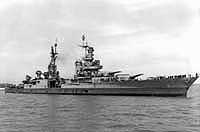The Ill-Fated Voyage of The U.S.S. Indianapolis

July, 1945. The allies have defeated the third reich, and now the british and americans are trying to end this bloody war once and for all. The only thing in their way is Japan, a force so strong and well trained that the war looks like it could go on for forever. Something needs to be done to bring upon their surrender, and the americans know exactly what that is. And so, on July 25, the flagship of the Pacific Fifth Fleet, the U.S.S. Indianapolis, delivered the components of the Hiroshima bomb to the island of Tinian.She would not make it home.
On Monday, July 30th, a japanese submarine under the command of Lt. Commander Mochitsura Hashimoto fires two torpedoes at the Indianapolis, and she sinks within fifteen minutes, and of a crew of 1,196 men, only about 800 make it out of the ship before she goes down.
And thus began a four day saga of survival for the remaining crew men. Of the 800 that survived the initial sinking, only 300 would survive their plight at sea. Some of them drowned, some of them were killed by shipmates (on the third day, it became evident that some members were actually drinking sea-water, causing them to have fits of delerium, some of which believed that other crew men were actually japenese.) Most of the fatalities though, were caused by sharks.
The sharks arrived soon after the first dawn, and would continue to be a constant menace to crew members. At first, the sharks seemed only interested in crewmen that had already perished. If a shark seemed too curious and charged a crewmen, they would pound the water and scream in an effort to scare the sharks away. This worked in some cases, although not all. There have been many first hand accounts published of the horrific attacks that occured on those four days. At one point when the water was calm and clear, the men could look down and see literally hundreds of sharks circling the depths below.By the third day, the average loss of crewmen to sharks was six an hour, and there was no end to this nightmare in sight.
Their salvation would finally come.
At 11:00am, Thursday, August 2nd, Luitenant Wilbur C. Gwinn spotted the life rafts while on a routine reconnaissance mission. Not only did he see the crewmen, but he also saw the sharks, later he described them as "in the thousands". So futile did they're plight seem that Gwinn actually landed his plane in the sea, and began to pick up the survivors.
For miles around the sea carried corpses, and desyroyers dispached to pick up survivors also acted as funeral directors. Because the sharks had been at work, identification was next to impossible.
In his action report, Captain of the U.S.S. Helm brought to reality how hideous the discovery of the bodies really was:
"All bodies were in extremely bad condition, and had been dead for an estimated four or five days. Some had life jackets and life belts, most had nothing. Most of the bodies were completely naked, and the others had just drawers or dungaree trousers on-only three of the twenty eight bodies recovered had shirts on. About half of the bodies were shark bitten, some to such degree that they more resembled skeletons. From one to five sharks were in the area of the ship at all times. At one time two sharks were attacking a body and continued to do so until driven off by gunfire. For the most part it was impossible to get finger prints from the bodies as the skin had been lacerated by sharks..."
On Wednesday, august 8th, 1945, the ships that had the duty of recovering the bodies returned home, leaving in their wake the graveyard of the U.S.S. Indianapolis, and the resting ground of over seventy-five percent of her crew.
BACK